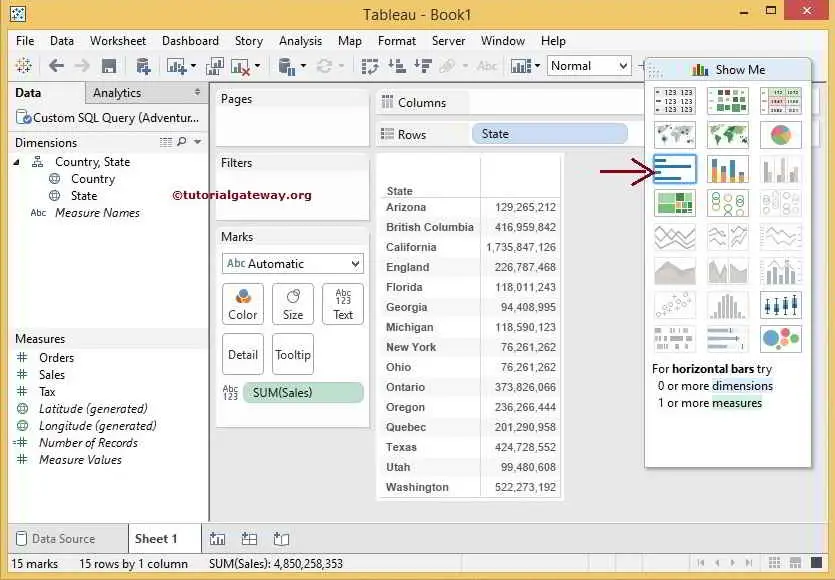

- #TABULAR REPORT IN TABLEAU HOW TO#
- #TABULAR REPORT IN TABLEAU SOFTWARE#
- #TABULAR REPORT IN TABLEAU LICENSE#

#TABULAR REPORT IN TABLEAU LICENSE#
After accepting the license agreement, you can verify the installation by clicking the Tableau Icon.
#TABULAR REPORT IN TABLEAU SOFTWARE#
Installationĭepending upon the choice of product, download the software on to the computer. The link for the source of reference is here. In this tutorial, we will be working with Tableau Desktop. Tableau Desktop, Tableau Public, and Tableau Online, all offer Data Visual Creation and choice depends upon the type of work The main products offered by tableau are: Tableau was established at Stanford University’s Department of Computer Science between 19 (Wikipedia) Tableau Software is a software company headquartered in Seattle, Washington that produces interactive data visualization products focused on business intelligence. Tableau is also compatible with multiple sources, including Excel, SQL Server, and cloud-based data repositories which makes it an excellent choice for Data Scientists. This feature helps to perform tasks like sorting, comparing and analyzing, very easily and fast. Tableau's ease of use comes from the fact that it has a drag and drop interface. Many businesses even consider it indispensable for data-science-related work. Tableau is a data analytics and visualization tool used widely in the industry today.
#TABULAR REPORT IN TABLEAU HOW TO#
Normally to create a table with different measures, you would use the generated fields for Measure Names and Measure Values.Our goal as Data Analysts is to arrange the insights of our data in such a way that everybody who sees them is able to understand their implications and how to act on them clearly. There is a parameter at the top that allows the end user to choose their minimum confidence level, then statistical significance is calculated for each recipe and each KPI. The special aspect of this table is that the circles are colored by whether or not the variant recipes performed differently than the control recipe with statistical significance. The label on each circle is a 100-point index score with a score of 100 indicating the variant performed the same as the control recipe scores above 100 indicate higher performance scores below 100 indicate lower performance. The table has a column for each variant recipe in a split test and rows for common web KPIs such as Leads / Visits Rate, Purchases / Leads Rate, Purchases / Visits Rate, and Revenue Per Visit. We will be focusing on the 100-point index table in the middle. To illustrate the need for this trick and provide a tutorial on how it’s used, we will be using this Tableau dashboard that is used to evaluate results for split tests on a company’s website: Plus, one of the best things about Tableau is how the community selflessly shares innovative techniques that can be built upon or used in your own way. While we did not invent the approach, it was too good to leave out of Tableau 201. How to Conditionally Format Individual Rows or Columns in Tableauīefore we share the trick to conditionally formatting individual rows or columns in Tableau, we would be remiss if we did not mention that we originally saw this documented by Dan Montgomery of in his post, My Favorite Tableau Trick for Work: MIN(1).įurther, we first heard about the trick from one of our Data Viz Heroes, Peter Gilks, of. This unlocks a great deal of formatting flexibility that is not apparent by default in Tableau. This post shares a trick for formatting the marks on rows or columns independently of each other. While Tableau certainly has many encoding options available through the Marks Cards, it can seem a little “all or nothing”.įor example, if you place a measure on the Color Marks Card, then all marks on the view are colored. This is very easy to do in Excel because you can modify every single individual cell exactly as you wish. One common such example relates to conditional formatting, and the ability to modify individual rows or columns. While there are tremendous advantages to using both programs, we have seen firsthand how learned behavior for Excel can become a barrier to adoption of Tableau. While there is some overlap between the reporting outputs of the two software programs, it can take some time to understand how the two programs differ as well as best fit together. Being that we almost all learned Excel first, it is natural to approach a tool like Tableau for the first time with some preconceived notions about how we think it should work.


 0 kommentar(er)
0 kommentar(er)
